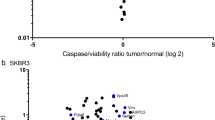Abstract
A monoclonal antibody (MoAb) H23 was generated in our laboratory against particles released by the T47D cell line. H23 MoAb recognized specific antigens in 90% of 590 breast tumor biopsies tested by the indirect immunoperoxidase test. Furthermore, the H23 MoAb detects antigens in sera and body fluids of patients with breast carcinoma. The level of serum antigen in 546 individuals tested correlates with the clinical status of the disease and with poor survival. The cDNA coding for the epitope recognized by H23 MoAb was isolated from a cDNA expression library and its sequence and orientation established. The nucleotide sequence showed that the cDNA insert was composed of 60 bp tandem repeats. We have analyzed the RNA isolated from primary human tumors, and it was demonstrated that breast carcinomas expressed the highest levels of mRNA species hybridizing with this cDNA. The gene coding for the cDNA was isolated from a genomic library and encompasses 7.5 kb. A 2.3 kb segment of this gene was found to be an array of tandem 60 bp repeat units whilst the remaining parts of the gene do not contain these repeats. The fact that these non-repeat sequences hybridize to identical mRNA species, has led to ongoing studies aimed at their further characterization.
Access this chapter
Tax calculation will be finalised at checkout
Purchases are for personal use only
Preview
Unable to display preview. Download preview PDF.
Similar content being viewed by others
References
J. Schlom, D. Colcher, P.A. Hold, F. Greiner, M. Weeks, P.B. Fisher, P. Noguchi, S. Peskta, and D. Kufe, 1985, Adv. in Cancer Res., 43:143.
F. Greiner, P. Horan-Hand, D. Colcher, M. Weeks, A. Thor, P. Noguchi, S. Peskta, and J. Schlom, 1987, J. Lab. Clinical Med. , 109:244.
J. Taylor-Papadimit, Jou J. Peterson, J. Arklie, R.L. Burchell, R.L. Ceriani, and W.F. Bodmer, 1981, Int. J. Cancer, 28:17.
R.L. Ceriani, J. Peterson, J.Y. Lee, R. Moncada, and E.W. Blank, 1983, Somatic Cell Genet. ,9:415.
D. Kufe, G. Inghiami, M. Abe, D. Hayes, H. Gusti-Wheeler, and J. Schlom, 1984, Hybridoma. , 3:223.
J. Hilkens, J. Hilgers, F. Buijs, P.H. Hageman, D. Schol, G. Van Doornewaard, and J. Van den Tweel, 1984, In: Protides of the Biological Fluids. 31, H. Peeters ed. Pergamon Press.
J. Schlom, D. Wunderlich, and Y.A. Teramoto, 1984, Proc. Nat. Acad. Sci. , (USA) 77:6841 .
I. Keydar, I. Tsarfaty, N.I. Smorodinsky, E. Sahar, Y. Shoenfeld, and S. Chaitchik, 1987, In: New Experimental Modalities in the Control of Neoplasia, ed. P. Chandra, Plenum Press, Ch 9.
Y. Shoenfeld, A. Hizi, R. Tal, N.I. Smorodinsky, G. Lavy, C. Mor, S. Schteren, I. Mammon, J. Pinhas, and I. Keydar, 1987, Cancer, 59:43.
I. Keydar, T. Ohno, R. Nayak, R. Sweet, F. Simoni, F. Weiss, S. Karby, R. Mesa-Tejada, and S. Spiegelman, 1984, Proc. Nat. Acad. Sci. , (USA) 81 :4188
J. Kolher, and C. Milstein, 1975, Nature. 256:495
I. Keydar, G. Selzer, S. Chaitchik, M. Hareuveni, S. Karby, and A. Hizi, 1982, Eur. J. Cancer & Clin. Oncol. , 3. D.F. 18:1321
D. F. Hayes, T. Ohno, M. Abe, H. Sekine, and D.W. Kufe, 1985, Clin. Invest. , 75:1671 .
L.D. Papsidero, G.A. Chrogan, M.J. O’Connell, L.A. Valenzuela, T. Nemoto, and T.M. Chu. 1983 Cancer Res. ,43:1741
L.D. Papsidero, T. Nemoto, G.A. Chroghan, and T.M. Chu, 1984, Cancer Res. , 44:4653.
J. Siddiqui, M. Abe, D. Hayes, E. Shani, E. Yunis, and D. Kufe, 1988, Proc. Natl. Acad. Sci. , USA 85:2320.
D.M. Swallow, S. Gendler, B. Griffiths, G. Corney, J. Taylor Papadimitriou, and M. Bramwell, 1987, Nature London, 328:82.
Author information
Authors and Affiliations
Editor information
Editors and Affiliations
Rights and permissions
Copyright information
© 1989 Springer Science+Business Media New York
About this chapter
Cite this chapter
Tsarfaty, I. et al. (1989). H23 Monoclonal Antibody Recognizes a Breast Tumor Associated Antigen: Clinical and Molecular Studies. In: Ceriani, R.L. (eds) Breast Cancer Immunodiagnosis and Immunotherapy. Springer, Boston, MA. https://doi.org/10.1007/978-1-4757-1296-4_15
Download citation
DOI: https://doi.org/10.1007/978-1-4757-1296-4_15
Publisher Name: Springer, Boston, MA
Print ISBN: 978-1-4757-1298-8
Online ISBN: 978-1-4757-1296-4
eBook Packages: Springer Book Archive




